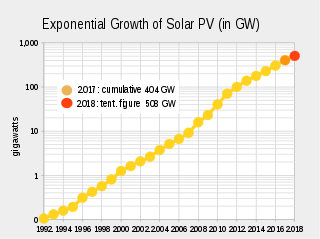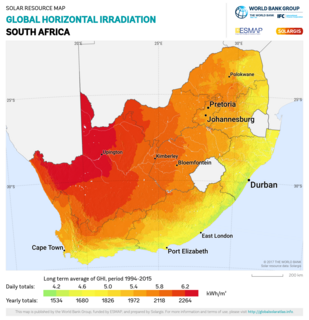
Many countries and territories have installed significant solar power capacity into their electrical grids to supplement or provide an alternative to conventional energy sources. Solar power plants use one of two technologies:

Spain is one of the first countries to deploy large-scale solar photovoltaics, and is the world leader in concentrated solar power (CSP) production.

Solar power in India is a fast developing industry as part of the renewable energy in India. The country's solar installed capacity was 56.951 GW as of 1 June 2022.
For solar power, South Asia has the ideal combination of both high solar insolation and a high density of potential customers.

Solar power represented a very small part of electricity production in the United Kingdom until the 2010s when it increased rapidly, thanks to feed-in tariff (FIT) subsidies and the falling cost of photovoltaic (PV) panels.

Historically, the main applications of solar energy technologies in Canada have been non-electric active solar system applications for space heating, water heating and drying crops and lumber. In 2001, there were more than 12,000 residential solar water heating systems and 300 commercial/ industrial solar hot water systems in use. These systems presently comprise a small fraction of Canada's energy use, but some government studies suggest they could make up as much as five percent of the country's energy needs by the year 2025.

Solar power in Japan has been expanding since the late 1990s. The country is a major manufacturer and exporter of photovoltaics (PV) and a large installer of domestic PV systems, with most of them grid connected. Japan has a solar irradiance of about 4.3 to 4.8 kWh/(m2·day).

Worldwide growth of photovoltaics has been close to exponential between 1992 and 2018. During this period of time, photovoltaics (PV), also known as solar PV, evolved from a niche market of small-scale applications to a mainstream electricity source.

Pakistan has some of the highest values of insolation in the world, with eight to nine hours of sunshine per day, ideal climatic conditions for solar power generation. However, the country has been slow to adopt the technology.

Welspun Energy Private Limited is an independent power company based in New Delhi, India. It is a subsidiary of Welspun Group.

During the first decade of the new Millennium Italy was the third country after Germany and Spain to experience an unprecedented boom in solar installations after actively promoting solar power through government incentives. In July 2005, the country launched its first "Conto Energia" programme supporting the development of renewable power. Growth in solar installations picked up immediately but it was the years 2009–2013 that saw a boom in installed photovoltaic (PV) nameplate capacity, increasing nearly 15-fold, and 2012's year-end capacity of over 16 GW ranked second in the world after Germany, ahead of the other leading contenders, China, Japan and the United States at that time.

A photovoltaic power station, also known as a solar park, solar farm, or solar power plant, is a large-scale grid-connected photovoltaic power system designed for the supply of merchant power. They are differentiated from most building-mounted and other decentralised solar power because they supply power at the utility level, rather than to a local user or users. The generic expression utility-scale solar is sometimes used to describe this type of project.

Solar power in Mexico has the potential to produce vast amounts of energy. 70% of the country has an insolation of greater than 4.5 kWh/m2/day. Using 15% efficient photovoltaics, a square 25 km (16 mi) on each side in the state of Chihuahua or the Sonoran Desert could supply all of Mexico's electricity.

Solar power in South Africa includes photovoltaics (PV) as well as concentrated solar power (CSP). In 2016, South Africa had 1,329 MW of installed solar power capacity. Installed capacity is expected to reach 8,400 MW by 2030.
In 2018 Chile produced about 7% of its electricity from solar power. As of year end, it had 2137 MW of solar PV capacity. In July 2020 installed solar capacity had risen to 3104 MW, with another 2801 MW under construction. At the end of 2021 Chile was ranked 22nd in the world in terms of installed solar energy.
Rewa Ultra Mega Solar is an operational ground mounted, grid-connected photovoltaic solar park spread over an area of 1,590 acres (6.4 km2) in the Gurh tehsil of Rewa district of Madhya Pradesh, India. It started producing power in 2018 and reached its full capacity of 750MW in January 2020. The project was dedicated to the nation by the Prime Minister of India Shri Narendra Modi on July 10, 2020. It was the first solar project in India to break the grid parity barrier. It achieved a first-year tariff of INR 2.97/unit, while the previous record was INR 4.34/unit.

Vikram Solar Limited is an Indian company based in Kolkata, the largest solar module manufacturer in India with 2.5 GW module manufacturing capacity annually and the second-largest solar energy company in India by revenue. The company's primary business focus is manufacturing solar PV modules and also carries out engineering, procurement and construction services and operations & maintenance of solar power plants.
The CIAL Solar Power Project is a 40 megawatt (MW) photovoltaic power station built at COK airport, India, by the company Cochin International Airport Limited (CIAL). Cochin International Airport became the first fully solar powered airport in the world with the commissioning the plant.
The Madhya Pradesh I solar park near Surajpur Village in the Shajapur district of Madhya Pradesh is a 200 megawatt (MWDC) photovoltaic power station, which is under construction. It was formerly known as solar park Northwest India I.














